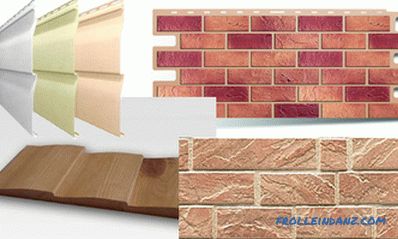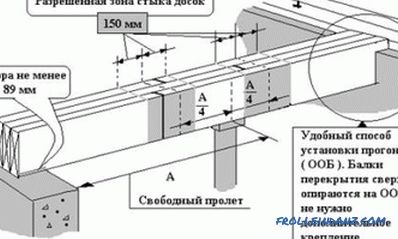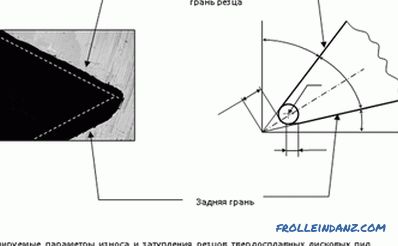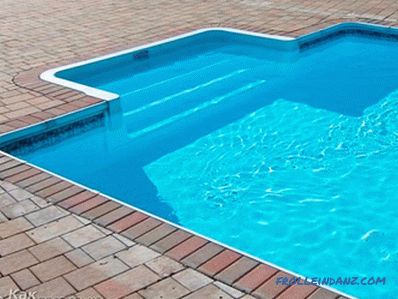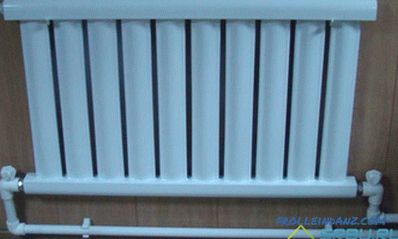It seems that the times of the old, clumsy cast-iron radiators of the Soviet type are passing. Today, people want to put in their place something more elegant and compact, but with good heat dissipation. We will tell about how to choose heating radiators that best meet these requirements.
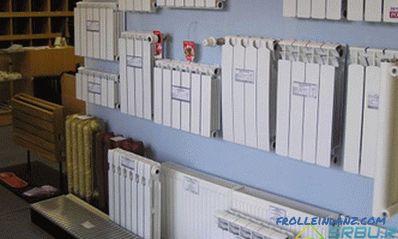
And from which, actually, the choice
is made up To begin with, we will provide a list of the main types of heaters offered by modern stores. Some of them can be supplied only in an autonomous heating system with its clean water and low pressure. And others can easily withstand fierce combat with water hammer and reactive water in centralized heating systems. Let's see what and how.
Cast iron - without it, and today no way
Let's start with the cast iron radiators mentioned at the beginning of the article. Do not think bad of them - modern radiators made of this metal look pretty nice. Budget models have flat neat surfaces and compact (compared to Soviet batteries) sizes. And exquisite retro models with beautiful casting drawings are the "nail" of the interior. Standing on graceful legs near the window, they give the room a special charm and a touch of antiquity.
Long stored warmly and not suffering from corrosion, cast iron products are able to work for several decades. The disadvantages of these devices can be considered their weight and the associated installation complexity, inertia and a large amount of coolant. In addition, the brittleness of the iron does not always allow it to withstand water hammer.
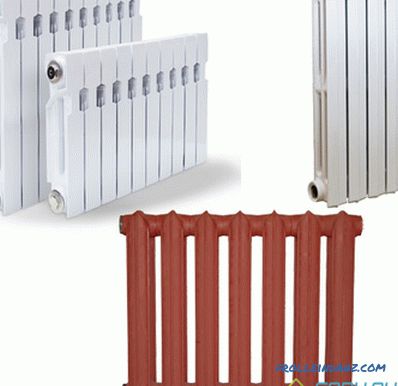
Pig-iron radiators of domestic and import manufacturers.
Light and beautiful aluminum radiators
For your own home this is a great solution - and they are not very expensive, and the design is diverse and stylish. If the water in the heating system is clean and its acidity is normal, then aluminum radiators will last 15-20 years. After all, low pressure in CO will not test them for strength, and neutral water will not cause a violent chemical reaction with evolution of hydrogen. Plus such batteries - low inertia.
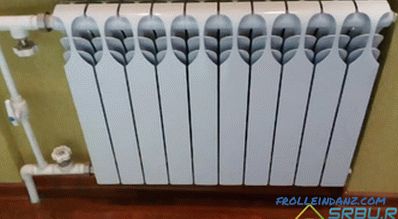
Note that there are two types of aluminum radiators:
- Extrusion radiators - they have sections glued together in three parts and pressed. The central part is extruded on the extruder, and the upper and lower headers are molded under pressure.
- Injection radiators are more reliable and durable, each section is molded under pressure.
For successful operation of aluminum devices it is very important to monitor the pH value, which should not exceed 7-8. Otherwise, the chemical reaction of aluminum with the release of hydrogen begins. This is detrimental to radiators and dangerous in fire. For air bleeding, it is necessary to install a Mayevsky crane (however, it is also necessary for other types of radiators).
Bimetallic radiators with high pressure on their shoulders
But this is already a good option for an apartment in a high-rise building where the pressure in the heating system is high. Not only that - there are his jumps, called hydraulic shocks. Bimetallic radiators, in which steel (or copper) strong pipes are hidden under the aluminum shell, will withstand pressure drops with ease. In addition, they, in contrast to their aluminum counterparts, are not “nibbled” by corrosion. After all, steel and copper are not at all as chemically active as aluminum.
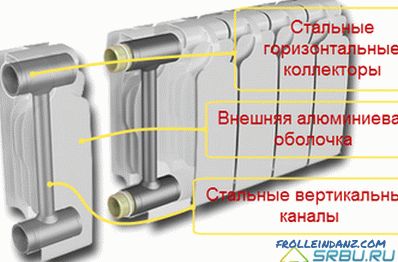
Bimetallic radiators, there are also two types:
- True bimetallic radiators - have a core in which there are no aluminum parts. It is completely made of steel (or copper) and does not corrode, unlike the collector of an aluminum battery. A corrugated case, under pressure "worn" on a steel core, gives a good heat transfer.
- Pseudo-bimetallic (otherwise, semi-bimetallic) radiators have a core in which only vertical channels are reinforced with steel. The remaining parts are aluminum. This increases the heat, but reduces the strength. Such devices have a lower price than true bimetallic heating devices.
In addition, bimetallic heaters can consist either of several sections, or be a solid monolithic product:
- Sectional radiators are convenient because you can sort them out if necessary . For example, when one section fails, or you need to increase or decrease the number of these sections, then all this can be done easily.
- Plus monolithic radiators in that they have a huge supply of pressure (about 100 atmospheres). Therefore, such devices - the best solution for "high-rise" with central heating, where the pressure in the system is very solid, and from water hammer sometimes do not escape.
Steel radiators are inexpensive and neat
Radiators made of steel have a modern design, low weight and good heat output. There are heaters of steel of two types - panel and tubular.
1. Panel radiators consist of metal-stamped sheets welded in pairs with oval grooves - channels for heat carrier. These are the panels, the number of which can be from one to three. To increase thermal efficiency, fins are welded from the inside of the panels - convectors. Finned models produce more heat, but raise more dust due to convection. Smooth panels are easier to clean, because of the lack of dust, they are great for children's and medical institutions.
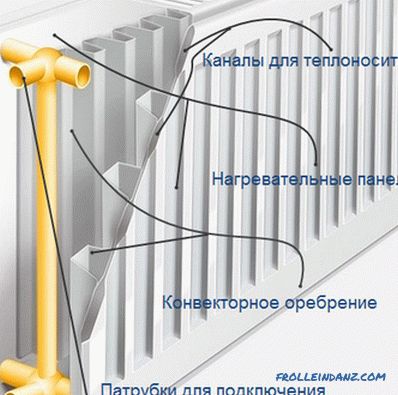
The device of a steel panel radiator heating.
2. Tubular radiators are a structure in which the upper and lower manifold pipes are connected by a series of vertical steel pipes. These radiators have a slightly larger margin in pressure than the previous type. Their cost is higher, and the design is more interesting and more original than those of panel models.
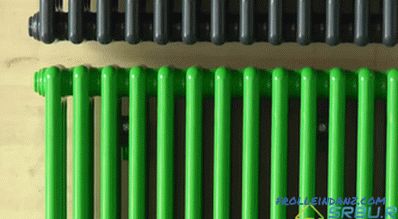
Floor convectors - warm with warm air
A tube made of copper or steel, equipped with fins for better heat transfer - this is the core of the convector. The shell of this heating element contributes to the movement of heated air from the lower zone to the upper. The convector is not afraid of high pressure and corrosion, has a slight hydroresistance. It is never hot (its body heats up to no more than 43 degrees). It is convenient to regulate it, since the device has low inertia.
But convection appliances, unfortunately, often do not heat the room evenly (it is hotter on the floor than on the ceiling), and also raise dust. Such devices are good where there are huge floor-to-ceiling windows. The radiator creates a thermal loop, and the cold does not penetrate the room. The disadvantages of these heating devices are uneconomical and not very high heat transfer.

Device of the sexual convector.
What are the main criteria for choosing radiators
Type of heating system
Perhaps it is from this that you have to make a start in the first place. There are two types of heating systems in our country: centralized and autonomous. And both of them require the use of different radiators.
1. Domestic centralized heating is characterized by high working pressure, as well as its jumps. The fact is that, unlike in Europe, we have a one-pipe system, in which radiators are connected in series. In addition, no one worries about the smooth inclusion of a centrifugal pump. And its sharp inclusion is fraught with hydraulic shock. And water in such a system does not shine with neither purity nor neutrality. It is tough, its acidity is high, and in the summer it is drained, which causes corrosion in many radiators. Therefore, such a system requires radiators that will withstand a working pressure of 6, and possibly 9 atmospheres (more they will say in the DES). Do not forget about the acidity of water, choosing a radiator that can operate at high pH.
The best choice for a central heating system would be:
- Cast iron radiators, characterized by durability and lack of a tendency to corrosion. Working pressure - 6-16 bar.
- Bimetallic radiators, also non-corrosive and withstand pressures up to 35 bar (sectional models) or up to 100 bar (monolithic models).
2. Autonomous heating is completely different from the central one. The water here moves in a circle (the two-pipe system), its pressure does not exceed 3-5 bar, and the acidity also meets the standards. No in this water and impurities. Therefore, almost all types of radiators are suitable for autonomous heating.
For an autonomous heating system, experts recommend:
- Aluminum radiators having the highest heat output.
- Steel radiators have a low price, featuring a beautiful exterior and original design.
- In some cases, you can use good old cast-iron radiators.
The use of bimetallic radiators in the autonomous heating system is not entirely justified due to their high cost and lower heat transfer compared with aluminum radiators.
Heat transfer of different types of radiators
Let us give specific figures on thermal conductivity (the value is indicated for one section) Naturally, the average values are indicated. More precisely, you can find the characteristics in the passport of a particular radiator.
Heat output of one section:
- Cast iron radiators - from 100 to 160 watts.
- Aluminum radiators - from 82 to 212 watts.
- Bimetallic radiators - from 150 to 180 watts.
Total heat output of non-sectional radiators:
- Steel radiators - from 1200 to 1600 watts.
- Convectors - from 130 to 10,000 watts.
To summarize. The leader in heat transfer is aluminum. Steel takes the second place. We will give the third one to the cast iron, which also heats up for a very long time (that is, it has great inertia). But he cools down for a long time, which sometimes comes to the rescue.
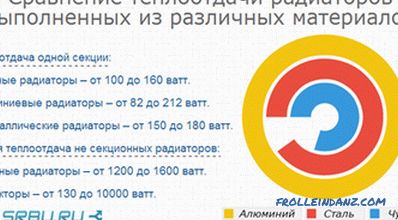
Which radiators are more reliable and durable
We will again provide in the form of a list the uptime, which manufacturers guarantee.
- Cast iron radiators are over 50 years old.
- Aluminum radiators - from 15 to 20 years (provided that the pH of the water is no higher than 7-8).
- Steel radiators - up to 15-25 years
- Bimetallic radiators - up to 20-25 years.
- Convectors - 10-25 years.
So, if, considering which heating radiator to choose, you put durability as the main criterion, then you don’t need to go far. Take the cast iron - no new-fangled radiator will last longer. Only the manufacturer choose a proven one that makes really high-quality batteries, using excellent raw materials and components. Behind him are bimetallic and steel radiators.
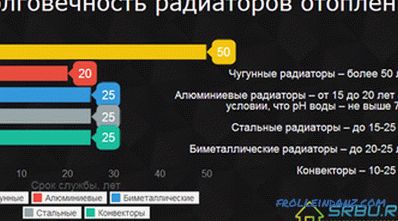
As far as reliability is concerned, there are two aspects here - the ability to withstand pressure and how this or that type of radiator is demanding of the heat carrier. If we talk about pressure, then bimetallic radiators will be the undisputed leader, followed by aluminum, cast iron and steel radiators.
But radiators refer to the coolant differently. The most enduring in this regard, are cast iron radiators, then go bimetallic. For steel radiators, it is important that the system is not drained from water for a long period, otherwise corrosion may occur if oxygen enters the system. Well, the most "gentle" are aluminum radiators that require a Ph in the range of 7 to 8 units.
Appearance and finish
1. Pig-iron radiators are models of domestic manufacturers, although they have become smaller in size, having undergone changes in design (their facade has become flat), but they cannot boast of finishing. They are coated only with an anti-corrosion primer, which implies subsequent painting. But the models of European manufacturers and the coating are beautiful and durable, and the design is quite modern.
Separately, it is worth mentioning retro-style radiators, they are expensive, but they simply look amazing.
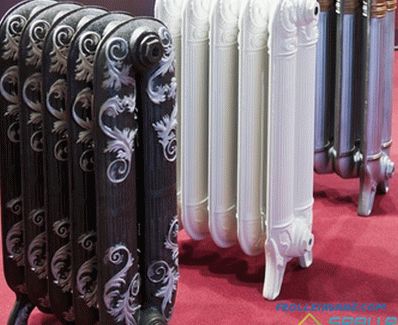
A variant of the performance of cast-iron radiators in retro style.
2. Aluminum radiators are distinguished by a variety of design. Many manufacturers produce multi-colored radiators, which look very elegant and attractive. Models of aluminum radiators are distinguished by a wide range of axle spacing and sizes. This allows them to fit perfectly into any corner of the house.
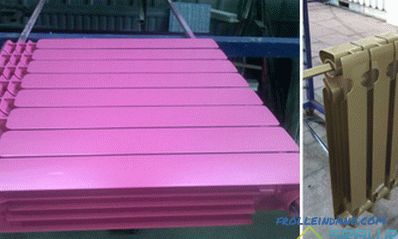
3. Steel panel-type radiators can fit into almost any apartment interior. Smooth panels are not very striking, harmoniously merging with the situation.

And tubular steel radiators often have an unconventional shape. For example, they may be angled or trapezoidal. And also they are protected by staircase steps, they are entered in niches and attic rooms. And everywhere such radiators look fresh and modern, shining with multi-colored paints.
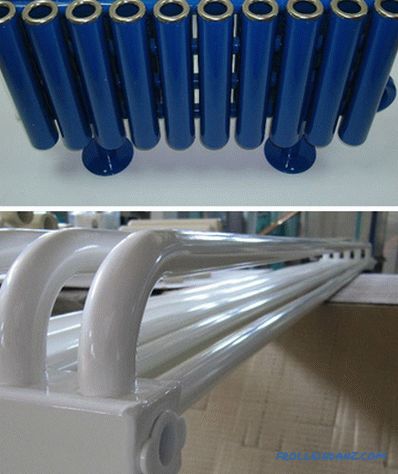
4. Bimetallic radiators are very sophisticated in design. There are many models that have not straight, but curved surfaces. This allows them to fit perfectly in rooms with smooth corners. Such products are produced, in particular, the plant RIFAR. The RS Bimetal radiator from SIRA also boasts smooth and beautiful curving lines.

RIFAR FLEX bimetallic radiator model with a rounded shape.
5. Sex convectors in terms of appearance differ only in decorative grilles.
Price categories
- Pig-iron radiators (except for "retro" models) - from 300 rubles per section.
- Cast-iron radiators "retro" - from 2000 rubles per section.
- Aluminum radiators - from 300 rubles per section.
- Steel radiators (the price for a whole radiator) is from 1,500 to 10,000 rubles.
- Bimetallic radiators - from 500-600 rubles per section.
The cheapest radiators are steel panel and cast iron, especially domestic proizvodstva. After them, aluminum casting radiators will go, extrusion models will be a bit cheaper. But the most expensive will be bimetallic radiators, cast-iron radiators in retro style and steel tubular models of radiators.
About manufacturers - famous and reliable brands
Classic-style cast iron radiators are produced by such companies as the Czech manufacturer VIADRUS, Spanish - ROCA, Italian - FERROLI, Belarusian (MOH), Turkish (DEMIR DÖKÜM ). We make them in Cheboksary (factory ChAZ).Retro models are made by ROCA (Epoca model), DEMIR DÖKÜM (Retro model).
Aluminum radiators are mainly made by Italians. So, these are companies RAGALL, ROVALL, DECORAL, MECTHERM, FARAL, INDUSTRIE PASOTTI, GLOBAL, FONDITAL, RADIATORI 2000. We have a Stupino SMK plant, as well as a company from Mias MMZiK. Each company has its own "chips" for the protection of radiators from corrosion. In particular, FARAL produces zirconium treatment of their inside. A good anti-corrosion coating is also available for Calidor Super Aleternum radiators, also manufactured by FONDITAL, also in Italy.
Steel tube-type radiators are produced by German companies ZEHNDER, BEMM, ARBONIA, KERMI. The Italian manufacturers are the company TET-A-TERM, and in Russia - KZTO from the city of Kimry, producing the Zavalinka model, on which you can even lie down. However, models of the same plan (benches) are made by ARBONIA and ZEHNDER. As for panel steel radiators, they are produced by the following manufacturers: German company KERMI, Czech - KORADO, Belgian - RADSON, Dutch - STELRAD, Turkish - DEMIR DÖKÜM, Polish-Finnish - PURMO), Italian - BIASI. In Russia, there are two companies: "MECHANICAL PLANT" from St. Petersburg and the plant "SVARTEPOTEHNIKA" from Tver.
Bimetallic radiators are made by firms from Italy (GLOBAL, SIRA), the Czech Republic (ARMATMETAL), Russia (Ryazan factory TsVETLIT-R, Moscow factory SANTECHPROM and an enterprise from the Orenburg region RIFAR). It is the products of the last manufacturer that are highly sought after and popular.
Convectors are produced by Russian (KZTO, IZOTERM and SANTECHPROM), American (SLANT / FIN), and European firms. For example, the Slovenian VTS CLIMA, the Polish CONVECTOR, the German KAMPMANNAN, the English BISQUE RADIATORS, the Belgian JAGA.
Selecting a specific radiator model
After you have decided on the type and type of radiators you need, it is time to calculate and select specific radiator data models that will have the necessary technical parameters.
Calculate the heat output
And how to choose the right radiators to achieve the proper level of heat and comfort? To do this, calculate the thermal capacity of the radiators planned for purchase. Certain standard conditions require heat output from 0.09 to 0.125 kilowatts per square meter of space. It is this power that should be enough to create optimal climatic conditions in the room.
Now about what is meant by standard conditions. It's simple, this is a room in which there is a window with a wooden frame and three-meter (not higher) ceilings, as well as an entrance door. At the same time hot seventy-degree temperature water flows through the heating pipes. If you have the same conditions, multiplying 0.125 by the area of the room you will get the power of the radiator or radiators (if you need several of them) necessary for the room. Next, it remains to look in the passport of specific radiators and, having learned there the thermal power of one section or the entire radiator, select the necessary model.
But this is a simple calculation, in fact you need to take into account some other factors that in this case will have an effect:
- You can reduce the power of radiators 10 - 20 % if you have installed plastic energy-saving double-glazed windows in the room, because by so much they reduce the heat loss of the room.
- If there are not one but two windows in the room, then it is necessary to put under each of them on the radiator. Their combined capacity should be 70% higher than the standard figure. We will do the same in the case of a corner room.
- As the temperature of the hot water rises or falls for every 10 degrees, the power of the device also increases (or decreases) by 15-18%. The fact is that if the temperature of the coolant decreases, the power of the radiators decreases.
- If the ceilings are higher than three meters, the heat output must again be increased. The increase must be made as many times as many times higher than 3 meters ceilings in the room. If the ceilings below means you need to make a decrease.
When calculating, we will take into account how our radiators will be connected. Here are a few recommendations about this:
- If the coolant enters the radiator from the bottom and comes out from above, then the heat will be lost well - from 7 to 10%.
- A side one-sided connection makes it unwise to install radiators longer than 10 sections. Otherwise, the latter from the pipe section will remain almost cold.
- Increases heat transfer from 10 to 15 percent by gluing a special reflective insulating material to the wall behind the radiator. For example, it can be such material as Penofol.
Of course, not all indicators are indicated here, for example, you need to take into account what material your house is built from, what its construction is, whether there is insulation, but in general they allow you to choose the necessary appliances for heating.
Determine the required dimensions
When you buy a radiator, you must know the following points:
- What type of eyeliner you have - hidden or open;
- How the pipes are connected to the radiator from the floor, from the wall, from above, from the side, etc.;
- The diameter of the heating pipes;
- The distance between the pipes (center distance ).
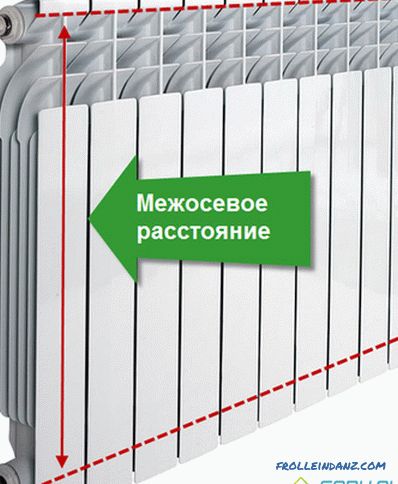
We also provide for the placement of a radiator so that air can flow around it freely — otherwise, the room will not receive heat from 10 to 15%. Standards for placement of radiators are as follows:
- Radiator distance from the floor - from 7 to 10 cm;
- distance from the wall - from 3 to 5 cm;
- distance from window sill - from 10 to 15 cm.

Basic standards for the placement of radiators.
The final stage of the purchase of radiators
Now, if you have autonomous heating, you can, taking with you these calculations, boldly head to the store for heating appliances. But residents of a high-rise building with a centralized CO, it makes sense to first go to the ECD, to find out what is in your heating system operating pressure. We will make a start from this parameter, deciding which radiator is better to choose. The pressure indicated in the passport of the instrument must be higher than that called by the employees of the DES, in order to get some reserve. After all, we should not forget that in each new season, heating devices are tested by pressing pressure, which is 1.5 times more than a worker.
